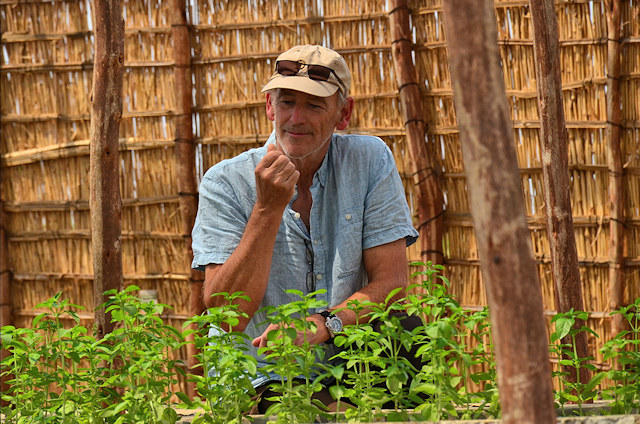
Facilitating climate smart circular bioeconomy in Malawi

This site depicts some projects and cases to demonstrate the portfolio and range of expertis of bioserve
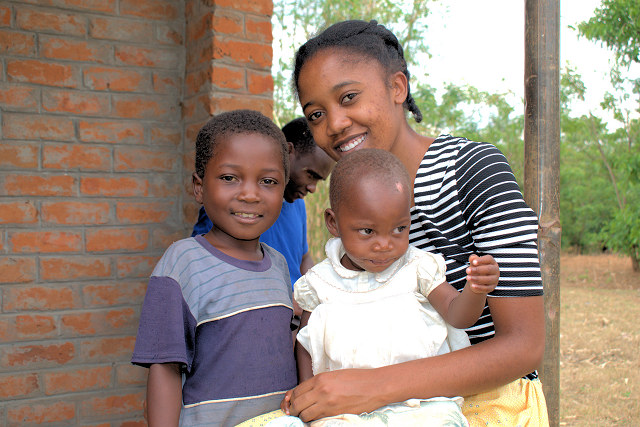
Traditionally, Malawi is a nation where a lot of fish is consumed. The main foodstuff has, however, become maize porridge. The overfishing of Lake Malawi since the beginning of the 1990s has led to the fact that the tilapia species O. karongae, in the national language "Chambo", is hardly affordable for most people in Malawi. Against this background, the project "I love fish" aims to improve the supply of the rural population with fish and vegetables.
In detail, the following project objectives are in focus: i) Improvement of the production of native tilapia species through improved rearing conditions and the production of "all male" fingerlings, ii) the construction of a solar-powered larvae rearing facility to supply the rural population with fingerlings from O. karongae (Chambo), iii) the application of integrated aqua-agriculture (IAA) in order to use the nutrients produced by fish for plant production, iv) the implementation of training courses to communicate expert knowledge and to support capacity building in rural communities, v) the investigation of the health status and nutritional habits of families in rural areas, especially those of children and older people, before and after the implementation of the project measures, and vi) supporting the establishment of a network and a knowledge platform to promote the exchange between the different communities and thus to ensure the sustainability of the project measures also after the end of the implementation by the project.
The project has also addressed another significant problem area, which is the lack of quality feed for juvenile and adult fish. One option is the production of insect larvae, which can be used in Malawi for the production of very cheap quality animal protein. This approach is now being pursued in the last project year until the end of 2020.

Malawi remains one of the poorest countries in the world. The economy is heavily dependent on agriculture and it is vulnerable to external shocks, particularly climatic shocks. Malawi has two very distinct seasons, with a dry season when agriculture and fish production is quite difficult. Thus, this proposal focuses on the nation-wide introduction of aquaponics as a climate smart production of vegetables, herbs, fruits and fish. Moreover, the aim is to combine aquaponics with the propagation of Black Soldier Fly (BSF) as a source of high-quality protein for fish feed.
Combining these two production processes will support the introduction of a circular bioeconomy in Malawi. Although in general neither aquaponics nor BSF propagation is a new technology, the introduction of a combination of both and the assessment of its economic and ecological feasibility under the special conditions in developing countries is a new approach. Specifically, the project aims to provide the technical framework for aquaponics and BSF production (production units, "modules") for about 30-40 families and cooperatives in rural and urban areas and will accompany the operation of the plants for about 3 years. The project will collect operational data over a longer period of time and to determine the framework conditions for economic and ecological viability of such systems.
In addition, the project will tackle the serious problem of tremendous food loss commonly found in DCs due to missing appropriate preservation methods. It is not only important to produce healthy food under sustainable conditions, but also to ensure that the food produced is fully available for consumption and not allowed to spoil. Thus, the proposal will introduce various simple, effective and affordable methods which achieve this goal under Malawian conditions. The participating stakeholders will learn how to process seasonal fruits, vegetables and fish into value added products with a longer shelf life.
The main objective of the project is to help to demonstrate how food production can be transformed into sustainable economies corresponding to a circular bioeconomy and how this transformation can be effectively implemented as best practices at a farm level to guarantee an overall higher ecological, economic and social performance at the village level and to contribute to achievement of sustainable development goals.
This project is still pending, but in previous projects it was shown, that both aquaponic and rearing of black soldier fly is a feasible technology under local conditions in Malawi. At present, we are looking for funding to be able to "translate" this innovative project into reality.
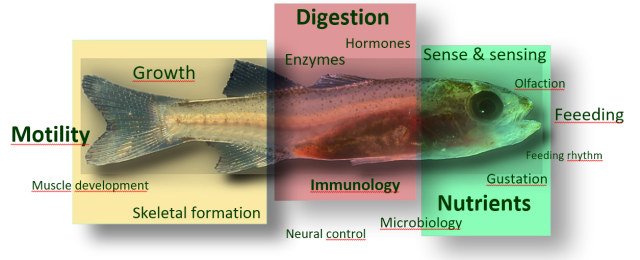
Sustainable growth of the aquaculture industry requires fry in a reliable quality and quantity. Despite considerable progress in aquaculture in the past 20 years, high mortalities during larval production and variable fry quality is still considered as a bottleneck for aquaculture production and is a major reason, that a number of marine species cannot yet be produced in an economically viable manner. The digestive physiology of larval stages has relevance to mariculture since many problems of survival and quality in fry production are apparently related to the performance of the digestive physiology during ontogeny. The quality of first feed which has to meet exactly the physiological and digestive capacities of the early larval stages is the major issue in the optimization process improving survival rates.
In marine larviculture, microparticulate diets have begun to rule the early larval stage hatcheries and the complete replacement of live feed in marine larval rearing is one of the last holy grails in fish larval production . The frequently published contributions about this topic demonstrates the tremendous interest of the hatchery scenery in microparticulate feed. This includes the rearing of marine fish larvae as well as the production of shrimp. There is no doubt about that formulated diets (Microdiets) which can replace the common live feed protocols such as rotifers and Artemia nauplii are among the most desired necessities. Part of the desire for a full replacement of Artemia nauplii in larval nutrition is the increasing shortage in good quality Artemia-cysts coupled with an ever-increasing price and the "natural" deficiencies in common live feed (i.e. rotifers and Artemia nauplii), which need boosting with various enrichments to achieve acceptable results. But this approach has its limitations and apparently, technically well designed microdiets can be used as a "transporter" for any kind of macro- and micronutrient and more. Artemia can also harbour bacteria and it has been found that feeding live prey to larvae can cause problems such as enteritis, stress, and create an imbalance in the rearing environment, which in turn can significantly reduce survival rates. Moreover, concerning brine shrimp the resource is limited. Looking at Artemia harvest data from the last 25 years, one learns that during years with favorable conditions the natural production peaks around 3,000 ton per year. All of these harvested cysts are consumed every year by the current aquaculture industry. On the other hand, according to the forecasts of FAO, World Bank and other entities, the yield from seafood production is expected to double during the next 15 to 20 years. It is obvious that such growth can only be realized when more fry can be produced with less Artemia.
The project "ProLarva" was aiming to improve the nutritional quality of first feed under consideration of micro diets with the goal eventually to facilitate the replacement the traditional live diets as first feed. Specifically the project focused on the investigation of the larval digestive physiology and aims at discovering ontogenetic and nutritional deficiencies in the first feeding phase, where usually the highest larval mortality occurs and was trying to identify diurnal rhythm in digestive enzyme capacity in order to provide recommendations for feeding regimes which consider the ontogenetic capacities in digestion efficiency.
Microdiets will become widely accepted if the same performance as in the common live feed protocols are achieved. Recent results from research trials in micro diet performance are very promising
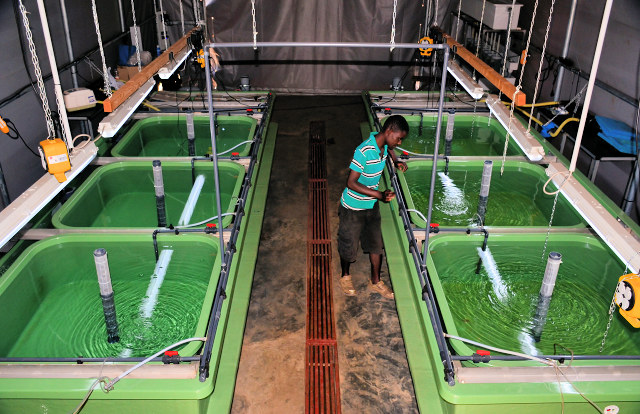
Propagation and production of fingerlings in
Malawi is usually conducted in ponds with
all species and generations of tilapia. This
implies, however, an unfavourable
environment for fingerling production,
including predation (predatory tadpoles from
frogs are a huge problem in open ponds),
cannibalism, feed competition and
environmental impact. Thus, the number of
offsprings which can be expected from the
farmer in a breeding season is unknown. Thus, one of the major goals of the project ¨Ich liebe Fisch" was to establish
technologies which improve significantly the
stable supply of viable fingerlings to
farmers which want to grow fish for food and
for the market. To achieve this goal, the
project has provided a solar powered indoor
hatchery which is designed to support
intensive production of tilapia fingerlings,
specifically for Oreochromis karongae (locally named "the real" Chambo). The design of
the hatchery is based on a design which has
proven it´s usefulness in fish
larval rearing since more than 25 years. The
design was adapted to the specific needs
under the conditions in Malawi and the
kind of species which will be reared in this
facility. The main elements of the hatchery
are two large fiberglass tanks with smaller
tanks hanging inside of the big tank. The advantage of this compact
design is obvious. The water conditioning
can be managed in the big tank (heating,
aeration, filtering etc.) without having any
mechanical impact on the larvae inside the
small tanks. On the other hand, the larvae
inside of the small tanks are practically
swimming in about 12 cbm of water. The water
in the big tank keeps the water temperature
constant for all smaller tanks, which is a
huge advantage if research trials will be
conducted in this facility. Each
unit has a two-way circulation and can be
operated in a batch mode, which means that a
certain volume of water, based on the
current water condition, is being exchanged
or the system can be operated in a
flow-through mode. The second option might
be difficult to apply under the conditions
in Malawi, since constant water pumping
often fails because of frequent failure in
grid electricity.
The prototype of
the hatchery was set up in March and April
2018 Bunda Campus aquaculture and fisheries
department farm in Lilongwe which is part of
the Lilongwe University of Agriculture &
Natural Resources and this facility was
ready to operate in the breeding season end
of 2018. In addition to the main rearing
tanks, an egg incubation unit was
established inside next to the tanks, based
on McDonald-type hatching jars. Since the
target species in the project are mainly
mouth breeders, the eggs can easily be
retrieved from the females. This facility
along with the rearing tanks completes the
full control over the entire hatching and
rearing process, facilitating also the
effort of selective breeding, in order to
improve the performance of the larvae and to
control the results of hybridization
experiments (one attempt in the project to
produce all-male generations).
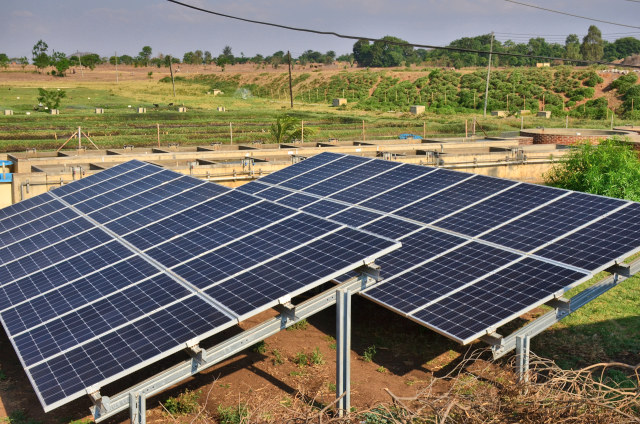
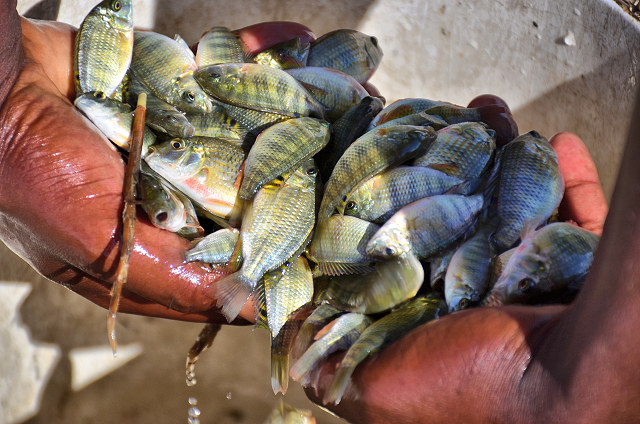
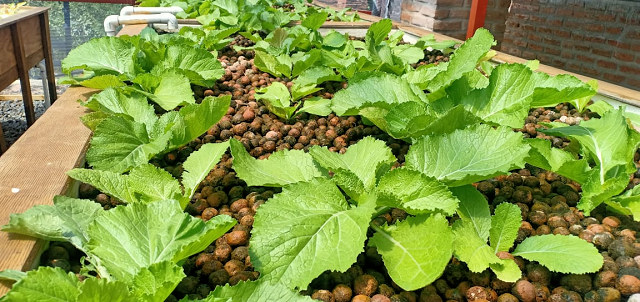
Aquaponics is the combination of aquaculture (i.e. raising fish) and hydroponics (the soil-less growing of plants) that grows fish and plants together in one integrated system. The vegetables make use of the nutrients which are defecated from the fish. Aquaponics uses only about a tenth of the water of soil-based gardening and helps to save water which is specifically important in Africa, in countries like Malawi, which relies to large extent on rain-fed agri- and aquaculture. Aquaponics has the following advantages: a) Aquaponics is organic by definition: instead of using chemical fertilizers, plants are fertilized by the fish waste. Thus, given the fact that low fertilizer use is one major reason of low farm productivity, e.g. in average less than 9kg/ha fertilizer is used in Sub-Sahara Africa compared to 100 kg/ha in South Asia and 73 kg/ha in South America; b) Water availability is optimized in aquaponics compared to rain-fed agriculture, while water use is significantly more efficient compared to classical irrigation systems, since water is recycled through the aquaponics. The growing problem of water scarcity demands improvements in water-use efficiencies especially in arid and semiarid regions, like SSA, where availability of water for agriculture, and water quality of discharge, are critical factors in food production. Recirculation of water in aquaponics units can achieve remarkable water re-use efficiency of 95-99%. Further, this system can bridge the dry season, at locations where no water for irrigation is available. c) Since the plants don´t need soil as substrate, aquaponics allows gardeners to produce more food in less space: These systems can be established in rural environments where land is very limited or of very poor quality;
Aquaponics has a low-cost for energy use because it may be solar-powered. Moreover, use of solar energy contributes to a low CO2-footprint. This system typically uses small photovoltaic facilities to circulate the water. Hence it can be installed in remote areas that are not connected to the main grid. Moreover, a very simple variation are the barrelponics systems which can be constructed from locally available materials and they require relatively low technical knowhow.

Until now, there has been only one source of data on global fishery catches: information reported to the Food and Agriculture Organization of the United Nations by member countries. An extensive, ten-year study conducted by The Sea Around Us Project of the University of British Columbia shows that this catch data is fundamentally misleading. Many countries underreport the amount of fish caught (some by as much as 500%), while others such as China significantly overreport their catches. The Global Atlas of Marine Fisheries is the first and only book to provide accurate, country-by-country fishery data. This groundbreaking information has been gathered from independent sources by the world’s foremost fisheries experts, and edited by Daniel Pauly and Dirk Zeller of the Sea Around Us Project. The Atlas includes one-page reports on 273 countries and their territories, plus fourteen topical global chapters. National reports describe the state of the country's fishery, by sector; the policies, politics, and social factors affecting it; and potential solutions. The global chapters address cross-cutting issues, from the economics of fisheries to the impacts of mariculture. Extensive maps and graphics offer attractive and accessible visual representations. While it has long been clear that the world’s oceans are in trouble, the lack of reliable data on fishery catches has obscured the scale, and nuances, of the crisis. The atlas shows that, globally, catches have declined rapidly since the 1980s, signaling an even more critical situation than previously understood. The Global Atlas of Marine Fisheries provides a comprehensive picture of our current predicament and steps that can be taken to ease it. For researchers, students, fishery managers, professionals in the fishing industry, and all others concerned with the status of the world’s fisheries, the Atlas will be an indispensable resource.

The use of digital tools provides many benefits for both the learner and the teacher, including the promotion of shared working spaces and resources, better access to information, the promotion of collaborative learning and a general move towards greater learner autonomy. Considering the Internet, there are now numerous options available, how to use digital information and communication tools (ICTs) in teaching and learning. However, there are still few teachers who have a comprehensive knowledge of the wide range of ICTs and can make use of digital tools with complete confidence. Aqua-tnet, the European Thematic Network in the field of aquaculture, fisheries and aquatic resources management has recognized these deficiencies and has introduced a working group into the Network agenda from 2006 to 2014 about "Innovative Lifelong Learning" which was dedicated to identify opportunities and help realise coherent pathways for lifelong learning in the aquatic sector in response to the challenges now facing education, developing innovative ICT tools and guidelines to enable greater transparency in assessment criteria and definitions of competence. By 2005, Aqua-tnet had become the largest multidisciplinary European Education Network in the field of aquaculture, fisheries and aquatic resources management. The network has promoted the use of digital means in teaching and learning, has organized hands-on workshops and developed online repositories and a template for an online course on aquaculture.
Digital tools, beyond some presentation programs such as MS PowerPoint, have not yet arrived within the daily routine in (classroom) teaching. However, learning today needs new pedagogical and technological approaches in using digital information and communications technology (ICTs). Teachers have the responsibility to prepare students for the requirements of an ever-changing world by facilitating learning in a technology-rich environment where students and teachers don't just learn about technology, they use it to achieve powerful learning and teaching, and improve student learning outcomes. Studies have shown that whilst students hold an expectation of digital transformation, in practice there is still much to do in supporting this change from a teaching perspective. There is still a strong mismatch between student expectations and staff capabilities and motives. The pedagogical reasoning and methodology for the use of digital technology is still unclear for some teaching staff, and this barrier prevents the efficient implementation of digital learning on the daily basis.
The AQUACASE website is an example for a digital tool in teaching and leaming about Aquaculture and has been under development throughout the AQUA-TNET3 project. AQUACASE is designed to provide information about different types of aquaculture facilities and related information, how they are built up, and how they operate. The purpose is to create a virtual tour of the facilities in order to provide much of the information you would get from a field trip. It is a free online portal facilitating Problem-Based-Leaming in aquaculture. It provides a set of well- illustrated aquaculture business case studies that can be used for a wide variety of aquaculture teaching and many more resources. In an educational context, this is meant as a supplement to traditional classroom teaching. The published material can also be used as background information for assignments as needed.
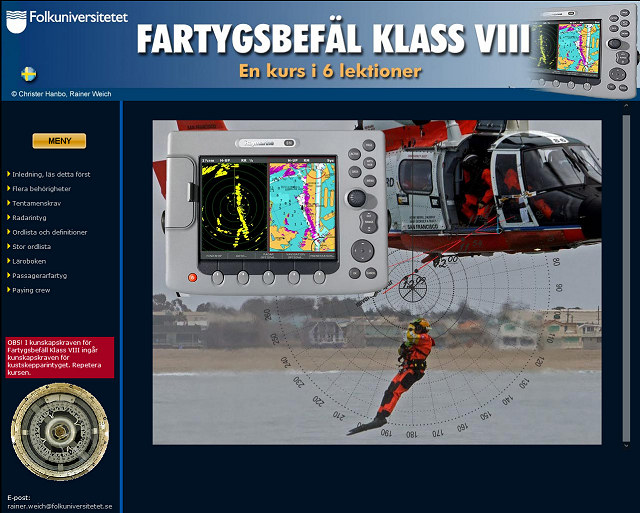
Bioserve Sweden publishes media for education in navigation, including books for yachting, ranging from coastal to astronomical navigation. In addition, online courses in navigation are published and applied in cooperation with the Swedish Folkuniversitet.
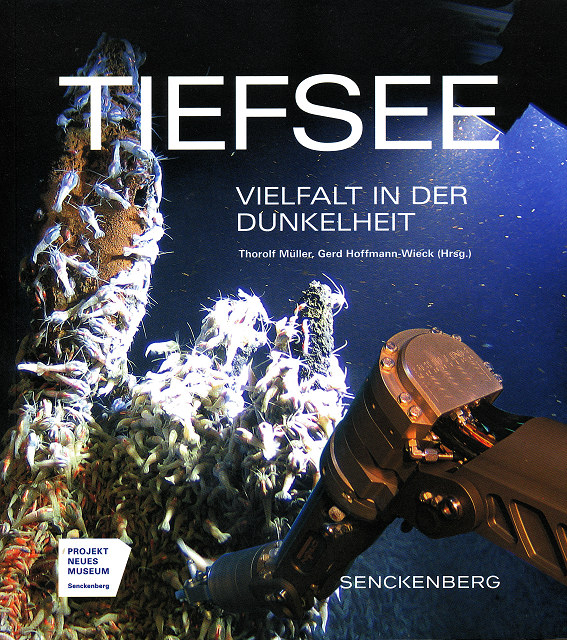
BioServe offers public educational presentations on levels customized to the audience. The topics covered are based on the expertise of the team members at BioServe. BioServe Sweden has recently developed an online course on environmental education.This online education is required and implemented by all employees in the city of Landskrona as part of Landskronas environmental management. Publications can be provided in English, German and Swedish.
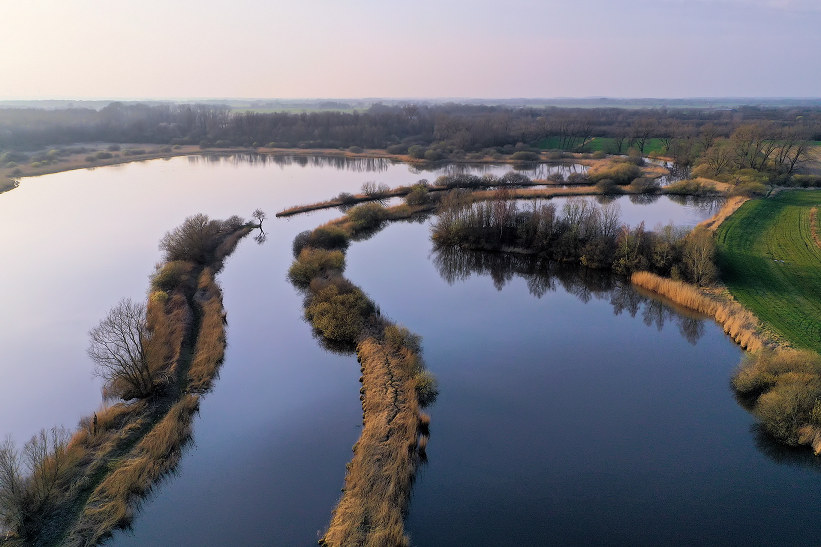
Visual content is king. BioServe provides photography services on a professional level tailored and edited for maximum impact to your needs in science related publications. Bioserve also offers a drone service for aerial pictures for e.g monitoring purposes (accreditation according to § 21a, Abs. 4 Satz 3 Nr. 2 Luftverkehrsordnung, DE.AST.035 and according to EU-Regulation VO (EU) 2019/947, ID DEU-RP-3813I97ocw90)